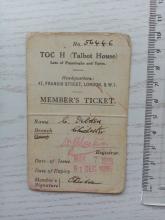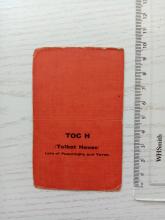The charity and international Christian movement Toc H has its roots in Talbot House, a World War One soldiers’ club in Belgium, started in 1915 by Neville Talbot, an army chaplain, and Rev Philip (Tubby) Clayton, originally as social centres with living accommodation for service men and women but with an emphasis also on service to the community. Talbot House was designed to be an 'Every Man's Club' where all soldiers, regardless of rank, were welcome.
The aims of Toc H were known as the 'Four Points of the Compass', summarised as: 'to love widely; to build bravely; to think fairly; to witness humbly.'
Name Origin: ‘Toc' signifying the letter 'T' (for Talbot) in the signals spelling alphabet used by the British army during the First World War, and ‘H’ for House.
The most common name for these clubs would become Toc H Services Clubs but they are also known as War Services Clubs, Servicemen’s Clubs, Services Clubs, Canteens, Talbot Houses, and more. Most followed a simple standard,a canteen, a reading and writing room, a chapel, and accommodation.
Between the Wars, Toc H became established in many countries round the world. In the late 1950s a Project scheme was established where young people could volunteer with environmental work, play schemes and work with the elderly, disabled or disadvantaged. Today as well as the above, branches may organise localised activities such as hospital visits and organising residential holidays for special groups.
The movement suffered a decline towards the end of the 20th century, and celebrated its centenary in 2015.
The Hong Kong branch of Toc H began at the end of the War, in Kowloon. Opening on the 19th October 1945, the building they planned to use had been badly damaged by Japanese troops. When sorting through the rubble the Services Team found a piece of stone with a Toc H lamp (its symbol) on it.
It turned out to be part of a memorial carved in honour of Toc H member Terence Ellacott, a civil engineer responsible for getting a road built to the local orphanage the local branch supported. Hong Kong fell before it could be completed and Ellacott sadly died. The Services Team was able to finish constructing a memorial to him.
In 1947, under the wardenship of Jim and Jeanne Stevens, Toc H moved from Kowloon to a house at 50 McDonnell Road on the island. This Talbot House was finally handed over for the branch to run in 1950 and it closed in 1954.
Wikimedia has images here from around the world.
Sources:




Comments
1945 Toc H Memorial
The Toc H Memorial that was discovered can be read here in the China Mail dated 7 November 1945.
1952-53 A Talbot Shelter and a move
In 1952 when Mildred Dibden started taking in babies again, Captain D* McAdam of Holt's Wharf, who was very active in Toc H work, built an open-air play shelter in the garden of her home in Ping Shan. It was called the Talbot Shelter.
A year later when the Toc H facilitated the move from the home to the Old Police Station in Shatin, this Talbot Shelter was transferred to a concrete playground on the land behind the house, which Toc H members had constructed, complete with swings, a swing-boat and see-saws. (Later on a swimming pool was added). On the day of the move a cavalcade of 12 cars came for the babies and staff, the dog and the cat.
Each November the family birthday was held, as little ones often did not know their actual birth date. Celebrations were spread over two days and included programmes of songs, dancing and mime entertainment for visitors who often numbered 200 or more.
Toc H workers would organise the tea, with refreshments liberally given by hotels, wholesale companies, grocers and confectioners. The party on the second day was for the family and birthday gifts were distributed to each child in turn.
* Not sure if this is D or H McAdam. Later on he is called H McAdam.
Source: The Yip Family of Amah Rock by Jill Doggett
Toc H help with children's air fares to the UK in 1966.
After Mildred Dibden flew to England with the last of her children in 1966, in her first newsletter to supporters that November, she mentions the help given by Hong Kong Toc H in this move:
In Hong Kong, Toc H had once more proved themselves true friends. Unknown to me, they had commenced a fund which was to be a farewell gift to the Family. They received nearly £1,000. This went a long way toward paying for the children’s passages to England; so that we could use our fixed deposits - both the children's and mine; to purchase our properties in Southsea.
1950s Toc H New Year Party
"Another evening of great entertainment occurred courtesy of Toc H members in Kowloon, where they arranged a Chinese New Year party for some of the poorest people in Hong Kong. These are the homeless women and children who attend The Street Sleepers Shelter Society. The group provided support all year round to the Society, having helped to source 2 large disused service huts, Nissan pattern, that they dismantled, transported and reconstructed themselves on one of the few empty patches of land that was left in the Chinese city. The shelter is lined along both sides with double-decker iron bedsteads with planks for mattresses, because Chinese people prefer to sleep hard, with a pillow of wood or porcelain. Toc H provided blankets but these had to be frequently replaced as the recipients often sold them.
The hut is run by a Chinese man but several times a week Michael Cheney, the Toc H Secretary called to help with the accounts and any other particular problems. On the night of the party, Toc H worked with the Chinese Red Cross and tables were laid and piled high with Chinese food, a real treat for the women and children who were more used to going hungry.
After the meal, amidst much noise and laughter the residents were given gifts, 10HK$ for the adults and oranges, sweets and toys for the children, a real party night for those who had little joy in their lives."
Source: This global history of Toc H
I'm hoping that others may be able to either supply pics for those places mentioned or info on organisations/people mentioned. The 1950s decade is a best guess for dating.
I've made a page for The…
I've made a page for The Street Sleepers Shelter Society.
Toc H provides BOAC tickets to the UK
In 1961 her Toc H friends approached missionary Mildred Dibden and asked her if she would like to see Britain again. In 30 years in Hong Kong, she had only seen her mother and UK brothers and sister twice, and her father and brothers and sisters in Canada less than that. Mildred replied that it was impossible as she couldn’t spare the money, which brought some enigmatic smiles from her enquirers. The result of their smiles was a BOAC air ticket to London. More than that, her return fare was paid for anonymously, and she was also given tickets for Canada to see her father, brothers and sisters there (she had 8 siblings). While she was in the UK, the London magazine Woman’s Own did a six-part serial of her story, which came out in 1962.
Source: Mission of Love, Woman's Own Magazine, London.